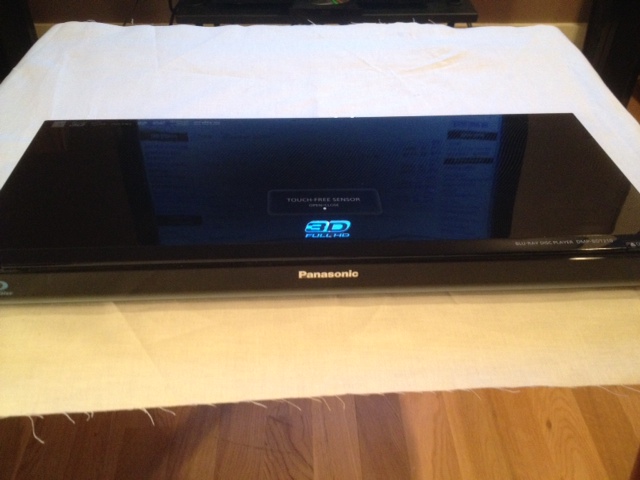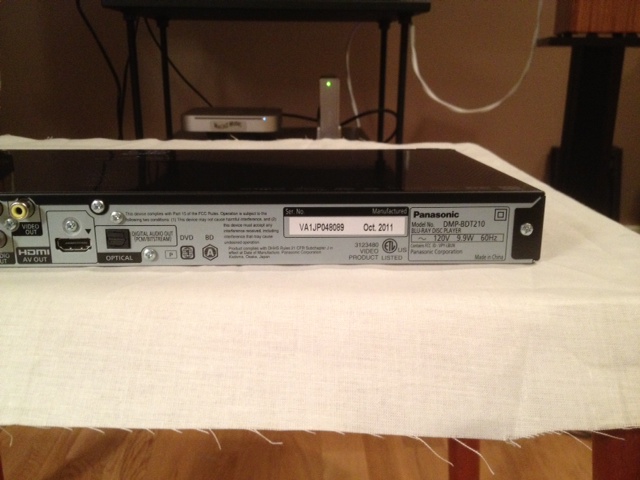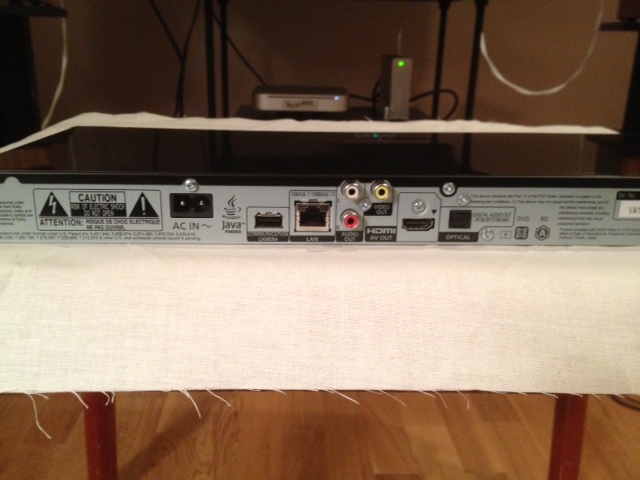


Top-rated 3D Blu Ray player, used for less than 20 hours and in like-new condition. Picture quality is first-rate. Going for $219.95 on Amazon.
CNET rated the BDT210 'Excellent.' Here's their review:
"The good: The Panasonic DMP-BDT210 has built-in Wi-Fi, a simple user interface, and an excellent suite of streaming-media services, including Netflix, Amazon Instant, Vudu, Pandora, Skype, and CinemaNow. The DMP-BDT210 also has the fastest overall disc-loading speeds we've tested. And though its "touch-free" disc tray opener is a little gimmicky, we found it occasionally useful.
The bad: The Panasonic DMP-BDT210 has fewer overall streaming services than some competitors, missing some high-profile services like Hulu Plus and MLB.TV. It also lacks onboard memory for accessing BD-Live features.
The bottom line: The Panasonic DMP-BDT210's built-in Wi-Fi, simple user interface, Amazon Instant streaming, and blazing fast disc-loading speeds make it our favorite Blu-ray player of 2011 so far.
PC Magazine got much more in depth and technical and rated it 4.5 out of 5 stars:
"The Panasonic DMP-BDT210 has almost everything you could want in a Blu-ray player. It sends great-looking images to an HDTV--in 2D and in 3D. It has a huge selection of streaming Internet services built in, with more on the way. It can play media files off SD Cards, as well as off flash drives or a local network. Despite some poor design decisions, those features are enough to make the $160 estimated street price (as of November 3, 2011) seem like a bargain.
The first thing you'll notice about the DMP-BDT210 is the blue logo on the top of the otherwise normal-looking black box. This is the Touch-Free Sensor, which can open and close the tray at a wave of your hand. Though the function seems kind of cool at first, your enthusiasm will soon wane. For one thing, waving your hand over the top of the player isn't really any more convenient than pressing an eject button. For another, you can't put anything on top of the player without unintentional consequences.
Luckily, you can turn the Touch-Free Sensor off--and you probably will end up doing so.
Another problem with the physical design: The front of the DMP-BDT210 is covered with a flap that comes down when you open the tray. That wouldn't be an issue, except that the flap doesn't automatically fold up when you close the tray, leaving a little shelf for you to bump into.
When you close the tray, the DMP-BDT210 loads Blu-ray discs very quickly (27 seconds in our Independence Day Blu-ray test, the second fastest we've seen). And once a disc is loaded, the images the player sends to an HDTV look superb. Our reference player, a current Sony PlayStation 3, provides very good image quality across the board, but the DMP-BDT210 either matched it or beat it in every test.
The DMP-BDT210 produced its most spectacular results in our black-and-white Good Night and Good Luck test (chapter 1). Thanks to perfect contrast, fine detail, and subtle shades of gray, everything in this clip looked better on the Panasonic player. It did almost as well in The Searchers (chapters 4 and 20). Here I noticed weaves in John Wayne's pants that I'd never noticed before. On a night scene actually shot in daylight hours, the player managed the difficult trick of making the image look dark without losing detail.
Why did these clips stand out? Probably because they look noticeably different from the other Blu-ray discs we tested. Good Night and Good Luck puts a greater strain on a player's ability to handle gray tones. And The Searchers was shot in 1956 in the high-definition VistaVision format, which provides more details in the source material, as well as highly saturated colors.
Our Phantom of the Opera DVD test (2004 version, chapter 3) also showed significant improvement, suggesting that the DMP-BDT210 does a better job than the PlayStation 3 when upconverting standard-definition video. I noticed very slight improvements in most of the other tests.
PCWorld doesn't formally test 3D image quality on Blu-ray players, but I tried Avatar (chapter 7), and it looked great. Several settings, all available from a 3D button on the remote, can help you adjust the twin images to match your screen size and your tastes in how 3D should look.
Another setting allows you to convert 2D programming to 3D. I'm not a fan of this kind of feature on principle--if something wasn't made in 3D, I don't want to see it that way--but I still would have been pleased to see it work. I wasn't pleased. The only 3D feel that I got from it happened when I pushed an info or menu button on the remote; in 3D, those menus and message boxes really popped.
If you don't have a disc handy that you want to watch, the DMP-BDT210 gives you access to plenty of Internet-based entertainment. Along with the standard services--Hulu Plus, Netflix, and YouTube--the player supports Skype (which requires a camera), three pay-per-view services (Amazon, CinemaNow, and Vudu), AccuWeather, MLB.TV, Napster, NHL, and Pandora. Panasonic designed the player to be upgradable, and additional services will likely appear in the future.
You access these services through an attractive and configurable screen. In a couple of minutes, you can place your favorite streaming services at the most convenient locations on your screen. Panasonic's YouTube user interface is comfortable and reasonably easy to use.
But I can't say the same about everything in this player. Although the first-time wizard and on-screen menus contain explanations, they're not always helpful. For instance, when you're selecting the TV Aspect (the shape of your TV and how you want to manage programming mastered in another shape), the player explains: 'To eliminate black/gray bars on the top and bottom of the screen when using with a Widescreen TV, select 6:9 Full.' In reality, that choice eliminates bars on the sides of the screen.
The pulsating animation on the home screen is annoying rather than attractive. Fortunately, as you dig into the setup menu, the animation disappears.
When you press the remote's Display button while playing a disc, up comes an unattractive menu box for changing various settings. Drill down into the menus a bit, into the Play section, and you'll find all sorts of technical information about the disc you're playing (such as its native resolution and audio format) that most modern players don't bother to tell you. This sort of feature isn't important to everyone; but to geeky folks like me, it's a treasure trove.
Like most modern Blu-ray players, the DMP-BDT210 can play your own video files through your local network and off a USB storage device, such as a flash drive. But unlike most others, it also has a slot for SD Cards--a handy option if you want to view photos or videos straight off your camera.
The player supports a comparatively limited number of media formats, though. The player didn't see my WMA audio files, or any of the seven video files I used in testing it. (You'll find a list of compatible formats on pages 6 and 39 of the downloadable manual.)
The remote control is small but sturdy, and it offers a nice grip. Some of the buttons are too tiny, but the play-control buttons (Play, Pause, Skip, and so on) are nicely placed, as is the circle of arrow buttons. Netflix and Skype buttons take you directly to those services. Unlike Samsung and Sony, Panasonic has not released mobile apps for controlling this player.
The Panasonic DMP-BDT210 has a few issues. But considering this player's excellent image quality and superb selection of Internet options, those issues are easy to overlook."